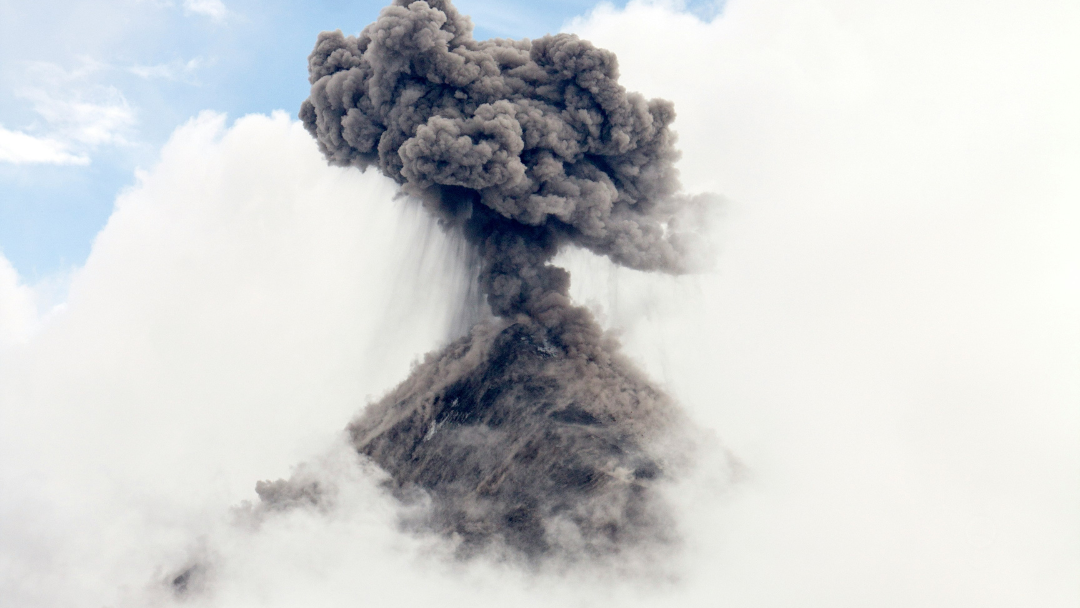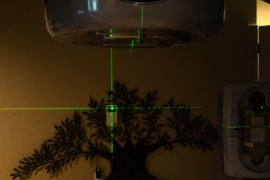1. Erakuyó
Buses drop you off at the closest village. You won’t see the volcano’s spitting peak through the tree crowns ahead, but you will hear the thrumming that sprawls all the way down to where you stand. Sometimes it sounds like thunder, but if by instinct you look up at the sky, locals are quick to point out that you’re looking at the wrong god.
Around here, people say that if you listen, you can make out words coming from the ground. They say that coyotes howl at it sometimes, a warning of something bad to come. You will be warned about violent assaults in the forest that surrounds it. You will be warned about the ghosts that roam its planes. But you will be safe, they say, if you stick to the trail and hire a guide to take you all the way.
Walk a little further up the road. You’ll see it outgrowing its skirt of trees, with charcoaled lips puckered up as if it’s kissing the sky. A crowd of guides will ambush you, pushing each other aside. You might feel overwhelmed with the weight of having to make a choice. Don’t. Though it may not seem like it, this group abides to a system.
The woman stretching her arm in front of you to block the others is Benigna Maderos. She is a widow with four children. She was raised on the skirts of this volcano and is bound to it by birth. She makes her living as a tour guide, always has, just like all the others around her. Seventy-five fifty in local currency, that’s what she’ll charge to take you up. It is the equivalent of eight dollars.
Shake Benigna’s hand. Notice her sad watery eyes, that dark papery skin, and the ashy scent exuding from her clothes. Pay her. She’ll appreciate the money up front. Now ask yourself whether the amount of money you’re paying her is enough, whether those bills she’s folding up will stretch as far as they must.
2. Lava
Your hike will start on the western side, amidst the smell of beef stew and corn tortillas wafting from market stalls that sprout whenever tourists show up. Walk past the backpackers snapping photos, past the woman with long black hair stirring the atol de elote, past the little boy sitting on the wooden table in front of her, pulling her breast out so he can nurse, past the old lady peeling corn next to her, with hands so dark and wrinkled they look like gloves.
There are no houses past the stalls. As you ascend, the scent of smoke stewed with jungle follows. The forest closes in around you. It is thick and green, an insulated capsule of fog where all noise is subdued, except for that soft palpation encased in it, it’s like being in a womb.
Benigna asks if you’ve ever seen lava before, her words emphasized by hurried breath. You’ve seen buttery caramel boiling, felt the heat of an oven on your skin. You’ve ogled at the Imax screen and eyed through National Geographic magazines. You know what lava is, of course. But you haven’t seen it crawl its way down, eating the fields close to this village, like a wave swashing on the shore. So shake your head and say, no.
Look up at the trees and the silence they impose. Look at the orchids, the ferns, the dark soil, and the dogs trotting past you through the mist. Breathe the damp, cold air into your lungs, and when you finally see the blackened tree stumps, stop. Gape, when the forest opens up, when that palpation enfolds you entirely, without asking if it can.
The boundary is clear. The grass fades, the ground dips, every single tree vanishes, and the ground turns completely black. Nothing lives here. Nothing can, except for the earth itself, and the grey sky.
Walk. Don’t stop. Look at the three people wandering about. When you see a smooth rock, the only one that is not porous and light, pick it up. You’ll have to use two hands, it’s heavier than it looks. Look at Benigna looking down, holding her backpack strap with one hand, and the small wooden cross she wears as a pendant with the other. Notice the silence that follows when she sees what you’re holding in your hands.
It’s a volcanic bomb. You’ve read about them: molten minerals that solidify mid-air before they hit the ground. Benigna is familiar with these bombs. A violent flame of anger ignites inside her whenever she thinks about them. It would ignite in you too if you had seen them flying through the air and puncture the frail aluminum sheets that act as roofs on the houses below.
To your right, there’s a little girl roasting marshmallows over a smoking fumarole. Watch as the little girl looks at Benigna, as the white marshmallow at the end of the stick she’s holding turns black.
3. Black and White
The maid’s tiny room is on the left hand corner of the roof terrace, right next to the storage room. On a clear day she has a beautiful view of Erakuyó and the two other volcanoes by its side. Sometimes, when the volcano puffs and the wind conditions are right, the entire city looks as if it’s covered by a sheer grey fabric.
The last time it happened, the two little boys she looks after came up to walk around in circles and watch their footprints mark the ashen terracotta floors. They drew stick figures on the maid’s room window until their mother called them back inside. The maid spent the entire morning sweeping and removing the ash from the terrace.
#
In a black and white interrogation video, the maid is sitting in a chair across from an investigator. The video quality is low, and her voice sounds scratchy.
She says she heard screaming in the house the night before the woman was reported missing. It woke her in the middle of the night.
The investigator asks if something like that had ever happened before. A few seconds of silence follow before she nods. The investigator asks what she did when she heard the screams that night. The maid looks around her, as if seeking permission to speak. The investigator nods.
The light came on in the terrace, she says. So she looked out the window. There’s a long pause before she continues. Yo creo que está muerta, she says. She looks up at the ceiling and shakes her head. Yo creo que está muerta, her shoulders shaking as she covers her face with her hands.
When the man asks why she thinks the woman is dead the maid is looking down. She mutters something under her breath. On the screen, you can see the man leaning in, asking her to repeat herself, at which point she lifts her gaze. She heard the door to the storage room close and then the lights went out, she says, but she saw a silhouette heading back into the house, with a golf club in hand.
4. Tuff
The crunching below your feet is sharp. You are walking over cows and horses. They used to feed on the fields surrounding the crater. They tried to run when the volcano erupted last time, but got trapped on a rise. They tripped over each other, panic stricken, until finally desisting, waiting for that lava to enfold them, to eventually turn them into the heat being pumped beneath you, the earth’s blood.
The words ALTO! PELIGRO! on the yellow signpost are almost completely illegible from corrosion, but if you look close enough, you can make them out. This is where the tour normally stops. Tell yourself that there won’t be an eruption while you stay. A strong eruption rarely comes. Then slide your hand into your pocket and stroke the money you’ve set aside. Notice your body heat escape you when you hand Benigna the money and tell her you want to go all the way up. When she smiles at you and flashes the gap from a missing front tooth, you know there’s no going back, so bite your lip and nod.
Look up at the rise before you. You’re so close and so far. Close your eyes. The constant tremor has grown around you, it’s like an underground truck. Put your jacket on, despite the heat rising from below, the air will only get cooler as you move on.
Let Benigna recite facts she has memorized as you climb: the altitude of eight thousand feet at the crater, toxic gases beneath the earth’s mantle and the conical shape built by many layers of basalt, tephra, pumice, and volcanic ash, counting with her fingers and pointing as she walks.
It’s hard to pay attention when you don’t really know much about minerals and your breath is so hard to catch. It’s the gases up here. They do strange things to the rock, the air, the sound. Sometimes, only sometimes, volcanoes shoot these gases up into the sky. They glide down in giant clouds, monsters that you can’t hide from, or outrun.
5. The Woman
El Diario newspaper prints a picture of the woman smiling, holding her two little boys, who are three and five. The headline reads, Still Missing. Following a police investigation, a luminol test reveals possible traces of blood in master bedroom carpet.
#
The woman’s sister is accosted by news cameras as her and her parents leave the police station. She has swollen eyes and black hair pulled back in a bun. When the reporter asks how she feels about her brother in law being named a prime suspect, she says she doesn’t know what to think and walks away.
#
In an article published in El Diario newspaper, the sister is quoted saying, “I tried to be there for him and the kids as much as I could throughout this entire ordeal, but he was cold and detached. Whenever he spoke of her, he used ‘was.’ I asked him why he talked about her in the past tense and he shrugged and… and then he turned to me and said, ‘Because she’s not coming back.’”
6. Sirens
One of the dogs growls at the air behind you and Benigna stops in her tracks. She looks at the dog, then at you. It’s like the wailing of sirens, the few seconds in between, when yout know something’s happened but you don’t know what it was. Accidentally drop your bottle of water on the ground when this happens. Look back and pick it up. The sound of crumpling plastic feels intrusive. You’re disturbing the sleep of a god.
The people you left behind are dots on the rugged black. They see you, but don’t worry about that. This is your decision. No one will contest it. Not here. Not now. Besides, your offense is minor compared to what takes place in the shadows of this country at night.
Es como un demonio, Benigna says, holding her arm over a smoking fumarole, feeling the volcano’s breath lick her hand. Now look at the dog digging its snout into the crevice right next to her. He will go no further. Watch as he sits back and stares at the black gap. He’s whining, as if waiting for something to crawl out.
7. Benigna
If you could see Benigna’s ghosts, you would see the intensity one of her little girls drinks milk with, if she can afford it. You would see the considerable plunge in tour work this year and her lack of such basic monetary funds. You would see the spells of menacing silence on the skirts of the crater. You would see her husband’s face, and hear the sound of rock puncturing aluminum, like piercing paper, playing over and over and over again in her head.
If you could hear her ghosts, you would hear the treading of four by fours approaching in the middle of the night. Most of the time it’s hikers or film crews, people with questions wanting to peer into the crater under moonlight, or at the crack of dawn. Sometimes it’s photographers and adrenaline junkies attracted to this giant she looks after, chasing an invisible prize.
Sometimes it’s a stocky stranger without questions or cameras, with nothing but a wad of money in his hand and something in the trunk of his car. Sometimes there is someone in the passenger seat staring out into the night, a feral animal ready to protect her offspring no matter what. Sometimes Benigna is told not to utter a single word. Ever. And she nods, knowing that she never will. She has four hungry children at home, remember?
If you could see the reason Benigna keeps waking up cold and sweaty at night, you would see a single woman beckoning her from the middle of the field of tuff. You would see Benigna running over to her, yelling that she has to get out of there as soon as she can! But the woman keeps on waving as Benigna runs to her. Then Benigna trips and falls, and when she looks up again, the woman is gone.
8. The Holy Vulva
A television news bulletin features a demonstration protesting the disappearance of women who haven’t been given a voice. The news anchor says the protest has offended Catholic parishioners across the city.
The screen cuts to a mob of women carrying a piñata shaped like a vulva. It’s about a a meter tall. The others hold posters of the virgin Mary wearing a dress that opens into a vulva.
“…to vindicate the vulva as the biological difference for which we receive violence and for which we are being murdered!” one of the protestors yells into the crowd. “More than seven hundred women were murdered this year! Seven hundred!” she says wiping a strand of hair from her face. “Not even a third of the cases made the court.” The camera lingers on her as the procession moves past.
The news anchor says that the National Episcopalian Conference expressed its strong opposition by calling the act a “buffoonish procession organized by a score of offensive and condemnable ladies” in the city centre.
9. Unschooled
The prosecutor’s office against organized crime initiated the investigation as a kidnapping, however, the prime parameter for kidnapping, meaning the expected ransom call, never arrived.
The suspect’s mother is the ex-president of the Supreme Court. She insists that her son has become the victim of a useless and corrupt system. “It is clear that she left of her own accord!” she says. “The reason a ransom call never came is because she doesn’t-want-to-be-found,” she says tapping her hand on the table with each word.
She speaks not as a mother but as a lawyer. She clings to the technicalities and the elements that must and haven’t been fulfilled in order to accuse her son of the crime. “What about the body? What about the weapon?” she asks. “It is a disgrace that this entire case is based on an unschooled woman’s testimony.”
10. The Crater
Erakuyó’s crater is a lot smaller than you’d expect. It’s a perfect dip, a charcoaled basin that swallows and spits out lava so gently that it seems to contradict the size and magnitude of the force at play.
A rotten stench clenches every organ inside you up here. The gases again. You are right to think you shouldn’t be here. But hey, it’s all about the thrill of feeling more alive by flirting with death. Statistically speaking you are in no more danger than crossing a busy road. Statistically. But there’s no way around the fact that you just hiked up an active volcano’s neck. So before you follow the urge to sprint back down, enjoy it for a moment. Heed that hulking rumble around you. Do you hear it? A beating heart, live and clear.
11. The God
Seventy-five fifty in local currency is the rough equivalent of eight dollars. It is a friendly hike up to that blackened field of tuff and a straightforward climb up to the volcano’s crater, past the smoking fumaroles, where you stand above clouds and a glorious view of the two other grey peaks by its side, where you can peer straight into its boiling mouth and chuck a stick in, a rock, frustration, your pride, an item of clothing perhaps, a body, a golf club, a shoe, anything at all. Whatever it is, the charcoaled mouth will hold it afloat for much longer than you would think, until it bursts into flames, until it swallows it, eventually merging it into magma to circulate it through the earth’s veins.
Occasionally, the volcano will spit it out again, furiously, as a fountain of oozing orange-red, as a giant cloud of ash and scorching gases, as an incredible force gushing out in pain.
When this happens, it occurs in two parts: along the ground, lava and pieces of rock will spill. Above, a giant, thick cloud of ash will form over the fast-moving flow. This cloud will transform the landscape drastically in a very short period of time. It will consume everything it encounters, scorch it, petrify it, and leave nothing, nothing but a carpet of cindery grey black.
12. Ghosts
The day it happens, a video will pop up on social media newsfeeds at twenty-four minutes past one in the afternoon. In it, the volcano’s lips will plume a grey cloud that reaches kilometers into the sky, a cloud that collapses and cascades down the side. Sirens will go off in the background while people stand on the edge of the road, filming and watching awestruck as the cloud descends over the trees before they start to run.
Benigna will have run out the door by then, with her children in tow, glancing back and watching the grey cloud come, devour the forest, her house, the entire mountain, the people at the tail of the road behind. She will have chased a pickup truck filled with people waving her over, telling her to hurry, to run! She will have shoved her children in front of her, handing them over to strange hands one by one. She will have felt the heat on her skin, the burning pain, and heard the stench of smoldering shock gaining behind.
By the time the video pops up, Benigna will have run faster than she has ever run in her entire life. She will have supplicated with every gasping breath, to God almighty, to Erakuyó, to her husband. She will have prayed with all her tainted faith, that all the scorching ghosts behind her, don’t catch up.
SHARON D. MERTINS is a fiction writer from Guatemala with roots in Panama, the US, and London. She now lives in Berlin, where she writes about strange natural forces and the uncanny. Her writing has been featured in Visual Verse, Cafe Irreal, Jersey Devil Press, Leopardskin and Limes, and The Wild Word Anthology, among others. You can follow her work at sharondmertins.com.
Get new stories, sports musings, or book reviews sent to your inbox. Drop your email below to start >>>
NEW book release
Direct Connection by Laura Farmer. Order the book of stories of which Mike Meginnis says there is “an admirable simplicity at their heart: an absolute, unwavering confidence in the necessity of loving other people.”
GET THE BOOK



